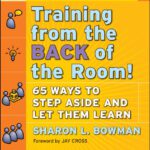“You are quite good at it, aren’t you? Can’t you show that to the others?” Are you sometimes pushed to brief your colleagues in your field of expertise? If so, you are in good company: at least most German companies, rely on this kind of information transfer. Unfortunately, however, the methods to teach well are often lacking. So here is a mini-train-the-trainer.

If you have ever prepared and held a workshop or training session, you know that it can be quite difficult to get your knowledge across to people. What is the best way to convey all the content? How to get all participants and listeners on board?
When it comes to passing on knowledge and information, the 4MAT® method is of great help. It can be used to adapt the content and structure of a lecture, workshop, or presentation to any audience. The 4MAT® training design is comprehensible, catchy, easy to learn, and ideally suited not only for professionals but also for “occasional trainers” (/1/).
Learning types or styles
In principle, the method assumes that there are four different learning types or styles. These are ALL inherent in EVERYONE, albeit to different degrees. People have distinct preferences:
- Why: People who mainly have this learning pattern ask the question of why they should deal with this topic. Only if they get a (good) answer to this, they are motivated to learn. If they don’t, the worst-case scenario is that they completely refuse to take in the information.
- What: The What type of learner is interested in EVERYTHING the topic has to offer. The more universal, the more details, the better! They need as much, accurate information and background information as possible. Otherwise, they are quickly bored and switch off.
- How-to: People with how-to learning patterns want to do things themselves. They want to try things out. They learn best by doing new things themselves, so they can have their own (learning) experiences.
- What-if: What-if people are the enterprisers among learners. They think “entrepreneurially” in the sense that they ask what they can do with what they are learning, what it will do for them, and also where the new thing might help them beyond its intended use. They like to ask: “What additional benefit does the subject have? Where and how?” In doing so, they become creative and immediately think about adaptations.

While we often know…
…WHO is attending the training sessions, but it is difficult to assess BEFORE the event WHO in the audience prefers WHICH learning style. If we knew that, we could easily decide whether, for example, a theoretical lecture is right for the group or a hands-on workshop.
However, since all people are equipped with all four learning styles anyway – just to different degrees – it is helpful (and also necessary) to address all four learning styles in the course of the event.
The 4MAT® method works with 4-step “LEARNING CIRCLE“:
1. Why – Motivation (Engage): Why should I engage?
The first step is to motivate participants to engage with the topic. Here the questions to be answered are: What is it about and most importantly (!): Why is the topic important? For the audience, the organization, and each individual.
The more emotional you succeed in addressing the issue, the more attention you will have in the group. (Helpful and particularly effective here is to address the VALUES of the group – if you know them, of course.)
2. What – Information (Share): What is it exactly about?
Now, the THEORETICAL INPUT with all the important information takes place. Your authority on the content, your expert opinion is required. Be sure to balance how much information you “dump” into the group: if it is too little, the information-hungry What types will switch off; if there is too much information, you will lose the practical How-To types.
3. What-if – Practice Part (Practice): Let me have a go
.
Now let the group have a go. The spirit should now be, “Now let’s give it a try EXACTLY as the expert tells us.” In courses, for example, exercises, group work, or discussions are done at this point. In computer training courses, the users now click through the program. If you do not have the possibility for a practical part, at least discuss how the practical use would actually look like.
4. How- to – Transfer (Perform): How does this help me?
The last step in the learning circle is the question: “What do we do with what we have learned in the future? How can we integrate what we have learned?” The motto of the group is now ideally: “Let’s try it our way!”
The effect is, on the one hand, that at the end everyone internalizes for himself or herself what he or she has just learned. On the other hand, what has been learned is mentally projected into the future and into one’s own processes. This is a mental technique and ensures that what has just been learned is anchored even more.
If you follow these four steps, you will be using several helpful tricks at once: For example, it has been proven that long-lasting learning success is only achieved if we have an emotional connection to the subject, i.e. we recognize a personal meaning for ourselves when learning. This is ensured in the Why step.
Moreover, learning means that connections are formed, synapses in the brain that is. Once created, these connections become better and better the more often they are used. You ensure this by following the steps of the model. In this way, the group deals with the content several times and in different ways.
Originally, 4MAT® was developed for adult education.
 USABLE…
USABLE…
…but of course, this method can be used wherever information needs to be transferred and (re-)actions need to be initiated in a sustainable way. For example, in emails, reports, speeches, meetings, customer talks, and telephone calls.
The focus is on the questions that should be asked in every successful communication. And also answered, that is:
- Why is a topic important to the recipient?
- What is it about in detail?
- What is the practical relevance and consequence of the topic?
 Was mir sonst noch dazu einfällt
Was mir sonst noch dazu einfällt
- Bowman, Sharon: Training from the Back of the Room!: 65 Ways to Step Aside and Let Them Learn
- McCarthy, Bernice, O’Neill-Blackwell, Jeanine: Hold On, You Lost Me! Use Learning Styles to Create Training That Sticks
- McCarthy, Bernice, McCarthy, Dennis: Teaching Around the 4MAT® Cycle.
- Vigenschow/Schneider/Meyrose: Soft Skills für Softwareentwickler.
- www.aboutlearning.com
 USABLE…
USABLE…